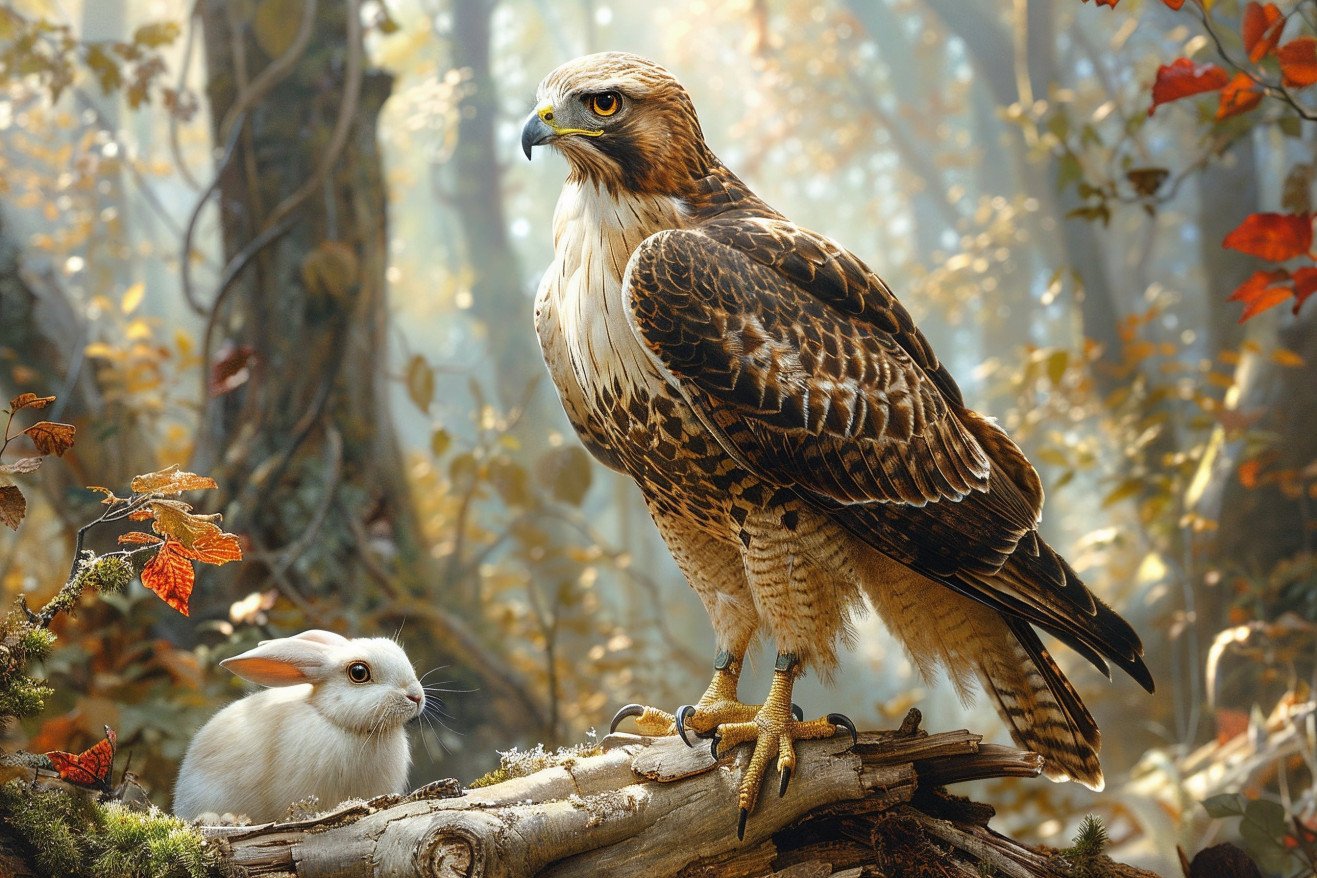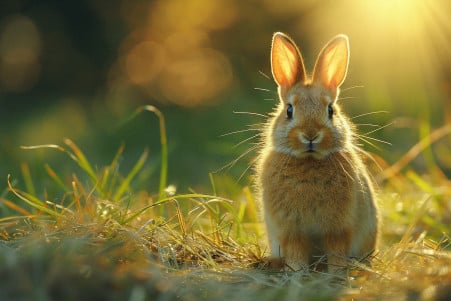Do Hawks Eat Rabbits? Exploring the Predator-Prey Relationship
26 April 2024 • Updated 25 April 2024

If you've ever seen a hawk dive down and grab a rabbit, you may have wondered if hawks eat rabbits regularly. The answer is yes, hawks eat rabbits. Hawks are predatory birds that eat a range of small mammals, including rabbits, as well as other animals like squirrels, mice, voles and other rodents. Their talons and beaks are designed to kill and rip apart their prey.
We will look at research from the fields of ornithology, ecology and zoology to learn more about the predator-prey relationship between hawks and rabbits. This research includes everything from how hawks hunt and choose their prey to how rabbits defend themselves and regulate their populations in the face of predation by hawks. Knowing about this relationship can help you understand the intricate food webs that help ecosystems thrive.
Do hawks eat rabbits?
Hunting Strategies: How Hawks Hunt Rabbits
Hawks are highly skilled hunters and use a range of hunting methods to catch rabbits and other small mammals. One of the most well-known strategies is high soaring, which is when large hawks such as red-tailed hawks take advantage of their wide wings to ride thermal air currents up to great heights, where they can then look down and spot potential prey.
On the other hand, smaller hawks may use low soaring, which is when they fly just above the ground in a straight line to surprise rabbits by diving on them. Meanwhile, the hover and pounce method involves hovering in place by flapping their wings quickly before diving down to catch their prey.
Hawks also use the perch and swoop method to hunt, where they wait on a high perch like a tree until they see an opportunity to catch their prey. They may also hunt cooperatively with one hawk driving prey toward another hawk that's waiting to ambush it, which is how Harris's hawks hunt.
Hawks use these and other hunting methods in different combinations depending on the environment, weather, and the type of prey they're hunting. Their keen eyesight enables them to see their prey from over a mile away, and they can dive at speeds of over 120 miles per hour to catch it by surprise. Once they've spotted a rabbit, a hawk's talons, which are extremely sharp, can exert a force that's 10 times the hawk's body weight to ensure a quick kill. Whether they're soaring high in the sky or waiting for the right moment to strike, hawks use a variety of well-honed techniques to catch the rabbits they prey on.
How Often Do Hawks Eat Rabbits?
According to a study on the diet and hunting habits of hawks, rabbits are a common prey item, especially for larger hawk species like the Red-tailed Hawk. Hawks are opportunistic hunters, and the frequency of their meals is based on the size of their prey. If they catch a larger animal like a rabbit, they may not need to eat again for several days. On the other hand, if they catch a smaller animal, they may need to hunt two or three times a day.
The availability and abundance of rabbits in a given environment will determine how often hawks eat them. While rabbits are an important part of the diet for many species of hawks, the frequency with which they are consumed is based on the availability of prey. Some species of hawks may even specialize in hunting rabbits, while others may have a more general diet that includes a variety of small mammals.
The frequency with which hawks eat rabbits can have a big impact on the population dynamics and overall balance of a given ecosystem. This is why it’s important to understand predator-prey relationships and how they impact the environment.
Ecological Impact: Hawks as Natural Rabbit Population Controllers
Hawks are important natural predators that help manage and limit rabbit populations in the environments they share. The Mercury News explains that rabbit overpopulation can lead to a number of problems, including the destruction of plant life, the disruption of food chains, and the spread of diseases. Therefore, it's important to maintain a healthy predator-prey relationship between hawks and rabbits to ensure the stability and well-being of the ecosystem.
Studies have even found that the targeted use of hawks and other raptors can be an effective way to control rabbit populations in areas where they have become too large. This has been done by falconers who have used hawks to control the damage caused by cottontail rabbits at golf courses. That said, the use of predators to control populations is an example of wildlife management that comes with ethical concerns.
While hawks are important for maintaining a healthy ecosystem, the role they play in controlling rabbit populations needs to be balanced with concerns about animal welfare and the need to maintain a robust and diverse wildlife population.
Rabbit Defenses: How Rabbits Avoid Being Eaten by Hawks
Rabbits have evolved a number of physical and behavioral defenses to avoid being eaten by hawks. As explained in Can Rabbits Defend Themselves Against Predators?, the rabbit's best defense is its ability to run and hide. Rabbits can run at speeds of up to 30 mph and their zig-zag running style makes it difficult for most predators to catch them.
Rabbits also have a number of senses that help them detect predators. As outlined in the Adaptive anti-predatory responses of European rabbits study, rabbits' eyes on the sides of their heads and ears that can rotate in all directions help them see and hear predators from a distance. When they do sense a predator, rabbits will often run and hide in burrows, bushes, or other hiding places that are too small for hawks to access.
Studies have also shown that rabbits can change their behaviors and social structures to better avoid predators. The Adaptive anti-predatory responses study found that rabbits living in high-predation areas were more likely to move away from cover, be more vigilant, and live in smaller groups, all of which make them less susceptible to ground-based predators like hawks. Rabbits living in low-predation areas, on the other hand, were more likely to exhibit less cautious behaviors and live in larger groups.
By combining their physical attributes, senses, and behavioral changes, rabbits have a multi-faceted defense against the threat of hawks. These defenses show how complex the predator-prey relationship between rabbits and hawks can be.
Coexistence and Balance: How to Sustain a Healthy Predator-Prey Relationship
The predator-prey relationship between hawks and rabbits is an important part of a healthy, balanced ecosystem. It’s important to sustain this balance because the loss or reduction of either species can lead to a number of negative and far-reaching consequences. For example, one study found that if the rabbit population was reduced, it would lead to an initial increase in grass growth, a decrease in snake populations, and a potential increase in hawk populations as they would have more rabbits to eat. However, in the long run, the ecosystem would eventually stabilize, leading to a new balance with different population numbers at each trophic level.
The natural predation of rabbits by hawks is important for ensuring that rabbit populations are genetically diverse and can evolve over time. As one study notes, the relationship between hawks and rabbits is not parasitic but is instead a balance that benefits both species through natural selection. This balance can only be maintained through careful management, including the conservation of natural habitats and ethical wildlife management practices.
In the end, the coexistence of hawks and rabbits depends on an understanding of the many complex, interdependent relationships in ecosystems. Studies have shown that when these relationships are disrupted, the consequences can be severe, which is why it’s important to take a holistic approach to managing ecosystems. By working with nature instead of against it, we can ensure that the ecosystems we live in remain healthy and adaptable for years to come.
Conclusion: Preserving Nature's Balance
The relationship between hawks and rabbits is a perfect example of the complex predator-prey relationships that are essential to a healthy, balanced ecosystem. Understanding this relationship is key to maintaining the web of life that supports the natural world.
Hawks are important natural population regulators, helping to keep rabbit populations in check and preventing them from growing too large. However, this balance must be maintained through responsible wildlife management and habitat protection. More research and education are necessary to fully understand these relationships and ensure that hawks, rabbits, and the other animals they interact with can coexist in a way that's healthy and sustainable.
By understanding the importance of predators like hawks in controlling the populations of their prey, we can work to ensure that the balance of nature that's so important to the long-term health and sustainability of our environment is protected. The relationship between these two iconic animals is a perfect example of the wonder and complexity of the natural world and a reminder of the importance of being good stewards of the environment.


